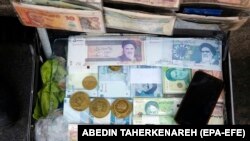Iran's national currency gained 10 percent of its value back on Monday after several deep plunges in the past few days following the injection of $300 million into the market for businesses seeking imports.
The rial hit an all-time low of 260,000 against the U.S. dollar on Sunday with an almost 10,000 rial drop in one day at the early hours of trading.
On Monday, however, it rose by about 10 percent to 22,950 against the dollar to gain the value it held ten days ago. This is still 43 percent less than its value in comparison with late March.
The Central Bank of Iran on Monday announced that it had injected about $300 million to its NIMA system [Persian acronym for Consolidated System of Forex Transactions] at an average of 183,000 rial to the dollar. The system regulates transactions between Iranian importers and authorized money changing offices.
In March 2018 after a sharp fall in the value of the national currency, the Iranian banking system introduced at least three different foreign exchange rates. The official rate of 42,000 rials per dollar, as well as the NIMA rate for more expensive dollars and the free [black] market rate which fluctuates. The plunge in the value of the rial has been attributed to the unavailability of dollars and other major currencies in the NIMA system.
The devaluation of the local currency, especially in the past few days caused all other markets including the property market to come to a standstill and would push the inflation rate to uncontrollable levels. Recently, the inflation rate was around 35 percent according to the International Monetary Fund (IMF).
The government faces a shortage of foreign currencies as U.S. sanctions have stopped almost all oil exports as well as a big part of non-oil exports. It has been leaning on exporters to bring back foreign currencies they earn, but people prefer to keep their capital safe fearing economic instability in Iran.









